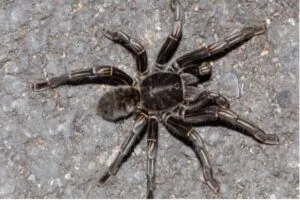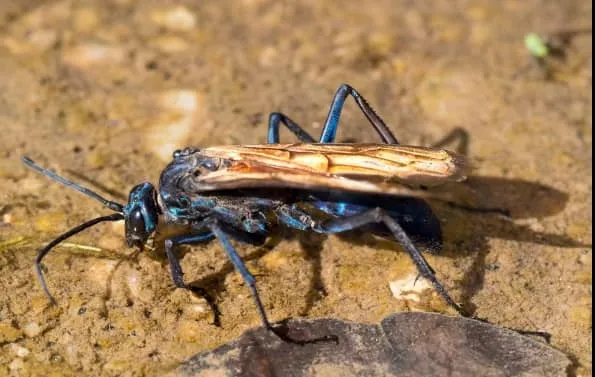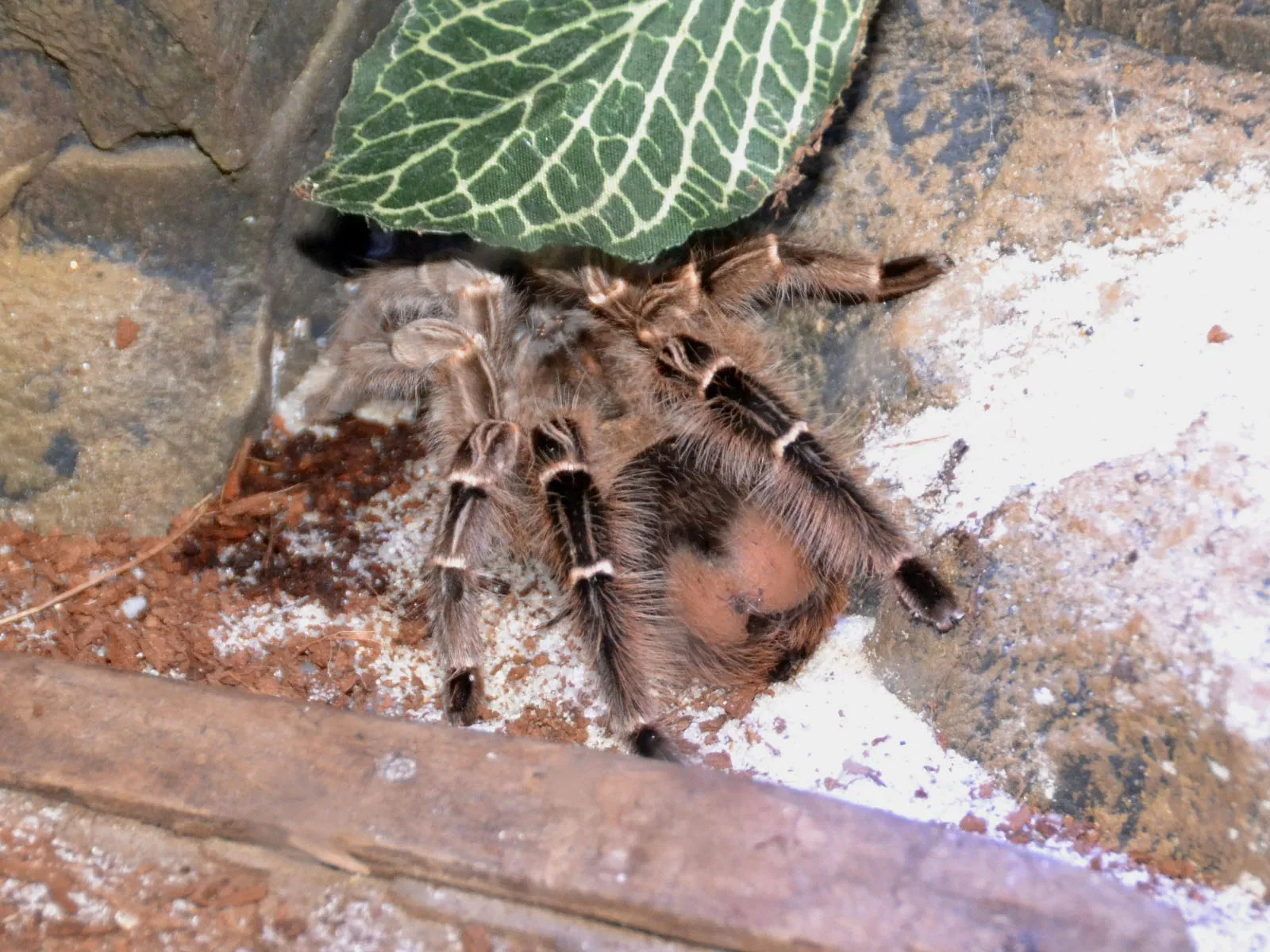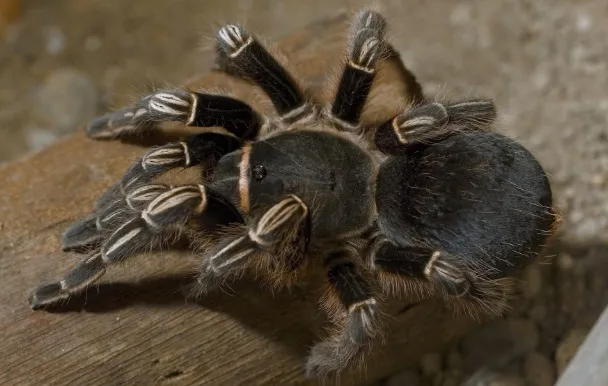The Zebra Tarantula, scientifically known as Aphonopelma seemanni, is a captivating spider species that has garnered attention from both arachnid enthusiasts and casual observers. Known for its striking appearance and relatively docile temperament, this tarantula is a popular choice for beginner and experienced pet owners. This article will delve into seven fascinating facts about the Zebra Tarantula, providing a comprehensive overview of its characteristics, habitat, behavior, and care. Prepare to be amazed by the intricate life of this remarkable creature!
Appearance and Characteristics
Understanding the physical attributes of the Zebra Tarantula is essential for identification and appreciation of its unique features. This section explores its size, coloration, and overall appearance. The Zebra Tarantula’s appearance is one of the reasons why so many people find them fascinating and intriguing. Their unique look makes them stand out from other tarantula species, and their manageable size makes them a great pet choice for the experienced and the novice.
Size and Physical Description
The Zebra Tarantula is a medium-sized tarantula, with a leg span typically ranging from 4 to 6 inches. Females tend to be slightly larger than males. Their bodies are robust, and their legs are covered in fine hairs, giving them a velvety appearance. The body is divided into two main parts, the cephalothorax (head and thorax fused) and the abdomen. The cephalothorax houses the tarantula’s eyes, mouthparts, and legs, while the abdomen contains vital organs such as the heart, digestive system, and reproductive organs. The overall build is designed for both hunting and burrowing, a testament to their adaptable nature.
Coloration and Markings

As the name suggests, the Zebra Tarantula is renowned for its distinctive zebra-like markings. The carapace (the upper part of the cephalothorax) is usually dark brown or black, while the legs are adorned with alternating bands of black and white or cream-colored stripes. These contrasting stripes make them easily identifiable and provide effective camouflage in their natural habitat. The abdomen often exhibits a muted pattern, blending in with the substrate and surroundings. These striking patterns are not just for show; they help the tarantula blend in with its environment, offering both protection and hunting advantages.
Habitat and Distribution
The Zebra Tarantula’s natural environment plays a crucial role in its survival and behavior. Understanding their habitat allows us to appreciate their adaptations and provide optimal care in captivity. This section provides insight into their preferred living conditions and geographical distribution. The Zebra Tarantula’s survival is closely tied to its environment, and knowing where they come from gives us insight into their characteristics and the importance of protecting their habitats.
Natural Habitat
Zebra Tarantulas are primarily terrestrial spiders, meaning they spend most of their time on the ground. They are native to the dry scrublands and grasslands of Central America, particularly Costa Rica, Nicaragua, and Honduras. They are well-adapted to arid conditions and often burrow underground to escape extreme temperatures and predators. These burrows provide shelter and a stable microclimate, crucial for their survival. They thrive in environments with moderate humidity and temperatures ranging from 70 to 85 degrees Fahrenheit. Their natural habitat is often characterized by sparse vegetation, making camouflage essential for hunting and avoiding being hunted.
Geographical Range

The geographical range of the Zebra Tarantula is primarily confined to Central America. They are most commonly found in Costa Rica, Nicaragua, and Honduras, but their range may extend slightly into neighboring countries. Their distribution is influenced by factors such as climate, vegetation, and the availability of suitable habitats. Understanding their geographic distribution is important for conservation efforts, as it helps identify areas where their populations are most vulnerable and where targeted conservation strategies can be implemented. Due to their popularity as pets, Zebra Tarantulas can be found worldwide, but their natural range remains specific to Central America.
Diet and Feeding Habits
The Zebra Tarantula, like all tarantulas, is a carnivore. Their diet consists primarily of insects, which they ambush and subdue. This section explores their dietary preferences and feeding behaviors. These spiders are opportunistic hunters, and their diet varies depending on their age and the availability of prey. Understanding their feeding habits is critical for providing adequate nutrition in a captive environment and ensuring their well-being. The Zebra Tarantula’s feeding habits show how it survives and thrives in its natural setting.
What Zebra Tarantulas Eat
In the wild, Zebra Tarantulas consume a variety of insects, including crickets, grasshoppers, beetles, and other small invertebrates. They are also known to occasionally prey on small lizards or even baby mice if the opportunity arises. In captivity, their diet typically consists of commercially available crickets and cockroaches. Mealworms and other insects can also be offered as a supplement, but should not be the sole source of food. The size of the prey should be appropriate for the tarantula’s size; it should not be larger than the tarantula’s abdomen. A varied diet ensures that the tarantula receives a range of nutrients, which is important for its health and development.
Feeding Frequency and Techniques

Young Zebra Tarantulas typically need to be fed more frequently than adults, usually every 2 to 3 days. As they mature, the feeding frequency can be reduced to once or twice a week. Overfeeding can lead to health problems, so it is important to monitor the tarantula’s abdomen for excessive plumpness. When feeding, place the prey near the tarantula, allowing it to hunt naturally. Remove any uneaten prey after 24 hours to prevent them from bothering the tarantula. Always ensure there is a shallow dish of fresh, clean water available for drinking. Proper feeding techniques are vital to the tarantula’s well-being, and observing its feeding behavior can be a rewarding experience.
Behavior and Temperament
The Zebra Tarantula is generally known for its relatively docile temperament compared to some other tarantula species, making them a good choice for those new to the hobby. However, it’s important to understand their defensive mechanisms and how to interact with them safely. This section explores their behavior and what to expect when interacting with these fascinating creatures. Zebra Tarantulas are known for being manageable in terms of temperament, but caution and respect are important aspects of owning them.
Defensive Mechanisms
While generally docile, the Zebra Tarantula does have defensive mechanisms. The primary defense is urticating hairs, which are fine, irritating hairs that they can flick off their abdomen when threatened. These hairs can cause skin irritation and itching if they come into contact with human skin. They may also adopt a threat posture, raising their front legs and fangs. Although they are not highly venomous, a bite can be painful, and it’s advisable to avoid handling them unnecessarily. Understanding their defensive behaviors is key to safely interacting with them.
Handling and Interaction

Handling Zebra Tarantulas is generally discouraged unless absolutely necessary, such as when moving them for cleaning their enclosure. If handling is required, it should be done with extreme care and caution. Always approach the tarantula calmly and gently. Avoid sudden movements that could startle it. Allow the tarantula to walk onto your hand, rather than trying to pick it up. Handle them over a soft surface, like a bed or a table, to prevent injury if they fall. It’s always best to observe these creatures rather than handling them, as it is less stressful for the tarantula. Proper handling shows the respect for the animal and ensures its well-being.
Lifespan and Growth
The lifespan and growth of a Zebra Tarantula vary depending on sex and environmental factors. This section explores their life cycle, including growth stages and how long they typically live in captivity. Understanding their growth and lifespan allows for better care and appreciation of these creatures’ life cycles. This knowledge helps pet owners to have a realistic view of the commitment involved in caring for them.
Growth Stages
Zebra Tarantulas, like all arthropods, grow by molting, shedding their exoskeleton. Young tarantulas molt more frequently, often every few weeks, as they rapidly grow. As they mature, the molting frequency decreases to once or twice a year. During molting, the tarantula is vulnerable and should not be disturbed. The process can take several hours, and after molting, the tarantula’s new exoskeleton is soft and its fangs are not as strong. The size of the tarantula will increase with each molt, which is a sign that they are growing and thriving. Observing the molting process is a sign of a healthy Zebra Tarantula.
Lifespan in Captivity

The lifespan of a Zebra Tarantula varies based on sex. Females can live for 10 to 15 years or even longer in captivity, if properly cared for. Males, however, typically have a shorter lifespan, usually living for 3 to 5 years after reaching maturity. The lifespan is influenced by factors such as diet, environmental conditions, and overall health. Proper care, including appropriate temperature, humidity, and diet, can significantly contribute to a long and healthy life for a Zebra Tarantula. Proper care and environment can affect the tarantula’s longevity.
Conservation Status
Understanding the conservation status of the Zebra Tarantula is crucial for ensuring its long-term survival. This section examines the threats they face and the conservation efforts in place to protect them. Awareness of the issues is important for preserving the Zebra Tarantula’s natural habitat. Conservation efforts are necessary to ensure that these amazing creatures continue to thrive in the wild. Their survival depends on addressing threats and supporting protective measures.
Threats to Zebra Tarantulas
The primary threats to Zebra Tarantula populations include habitat loss due to deforestation and agricultural expansion, as well as the impact of the pet trade. Collection from the wild for the pet trade can negatively impact their numbers, especially if not managed sustainably. Climate change and environmental degradation also pose threats to their survival. Protecting their habitat and managing the pet trade are crucial steps in safeguarding these creatures’ futures. Zebra Tarantulas are endangered by human impact and environmental change.
Conservation Efforts

Several conservation efforts are in place to protect Zebra Tarantulas and their habitats. These include habitat preservation and reforestation projects. Sustainable pet trade practices and responsible breeding programs can help reduce pressure on wild populations. Public education and awareness campaigns also play a crucial role in promoting the conservation of these fascinating spiders. The Zebra Tarantula’s preservation relies on awareness and the active involvement of different stakeholders.
The Zebra Tarantula Conclusion
The Zebra Tarantula is a remarkable species, offering a glimpse into the fascinating world of arachnids. With its unique appearance, manageable temperament, and intriguing life cycle, it continues to capture the attention of enthusiasts. Understanding their characteristics, habitat, behavior, and the importance of conservation provides a deeper appreciation for these creatures. By promoting responsible pet ownership and supporting conservation efforts, we can ensure that future generations can appreciate and learn from the magnificent Zebra Tarantula.
